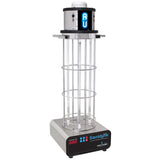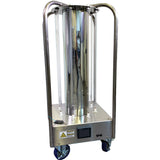Moderate Levels of CO2 in Indoor Air May Cause Occupant Fatigue and Lower Cognitive Performance
Posted by Dave on for ProLampSales
The importance of indoor air quality for work and classroom environments has become, with a strong push from the COVID virus, a top-of-the-list priority for building owners and managers as workers and students return to offices and schools.
The strategies for cleaning indoor air of pollutants that adversely affect occupants differs depending on the contaminant. For protecting occupants from a virus or bacterial infection, a common approach is to use ultraviolet germicidal (UV-C) equipment to sanitize the occupied space.
For mitigating other pollutants, such as CO2, particulates and volatile organic compounds, managing ventilation and filtration are the usual approaches. Fortunately, unlike viruses and bacteria, these pollutants can be monitored with diagnostic sensors that allow the building owner/manager to identify which contaminant needs to be addressed and where in the building it has reached elevated levels.
Carbon Dioxide (CO2)
This blog post focuses specifically on carbon dioxide, CO2. With one atom of carbon and two of oxygen, this common molecule is most often in the news as one of the heat-trapping gases in the atmosphere contributing to global warming. Outdoor levels of CO2 have been increasing due largely to burning of fossil fuels.
Sources of CO2 relevant to indoor air quality include human respiration. People exhale CO2. When a group of people are in a meeting room with poor ventilation for example, the CO2 levels in the air can quickly rise.
Exposure to CO2 levels at even moderate concentrations can cause adverse effects for occupants of a space. The most common effect on humans at elevated levels of CO2 is drowsiness, fatigue and loss of focus. Higher CO2 levels may cause headaches, dizziness and restlessness. Extremely high levels elevated blood pressure, coma, asphyxia, and convulsions may result.
Indoor CO2 is produced by people in the space exhaling (everyone!) and sources of combustion outside the space that leak into the building. CO2 usually builds up indoors when there is insufficient ventilation. A classroom with 30 students, a conference room filled with people and a building located adjacent to a busy street are all likely candidates for elevated indoor levels of CO2.
In a recent case, an older elementary school classroom was monitored, after teacher complaints, and found to have four times the level of CO2 found in outdoor air.
Impact of a Moderate Increase of CO2 Level in Indoor Air
When CO2 levels in blood go up, the amount of oxygen reaching the brain is reduced. The effect is drowsiness and impaired cognitive function. Students and employees lose focus. Learning and workplace productivity are affected.
While levels of CO2 in indoor air in workplaces and classrooms are unlikely to get high enough to cause severe health effects, even slightly elevated levels of CO2 can result in lower cognitive performance and productivity.
Carbon dioxide levels are measured in parts per million (ppm):
- 400 ppm - normal (approximate CO2 level in outside air)
- 1000 ppm - moderate (may cause drowsiness and loss of focus)
- 2000 ppm - unhealthy
- 2500 ppm - very unhealthy
- > 5000 ppm - hazardous
Studies show that cognitive effects of CO2 occur at concentrations of around 1,000 ppm. Reduced cognitive performance can result when a person is exposed to this concentration for only one hour. (For more, see https://www.nature.com/articles/s41893-019-0323-1)
Monitoring Indoor Levels of CO2
Most work spaces and classrooms rely on ventilation systems to keep the indoor air healthy. As energy codes have resulted in tighter buildings, ventilation has become an even more important factor in the quality of indoor air. However, most building managers do not have a tool to measure levels of indoor pollutants, including CO2, to know if there is sufficient ventilation and how the levels may vary in different areas of the building.
Here is a screen shot of the data feed from one of the sensors on the market. We’ve selected the CO2 tab on the graph (this monitor allows the operator to select the overall index as well as specific pollutants).

The space is a 200 square foot newly constructed office with continuous ventilation. There are two occupants in the office. The CO2 level is at a somewhat elevated 786 ppm which is below the usual first level of concern at 1000 ppm, but it even at this level sensitive occupants could begin to experience drowsiness. If a third person comes to the office for a one hour meeting, the CO2 level would almost surely reach 1000 ppm.
Monitoring CO2 and other Indoor Air Contaminants

Optimized indoor air quality starts with monitoring. Indoor air quality monitors are now available with Wi-Fi, Ethernet, RS-485 and BACnet connectivity to computer and cloud based dashboards. A continuous stream of data from multiple sensors provides building owners/managers with a detailed view and historical record of CO2, particulate, VOC, ozone, humidity and temperature in various occupied spaces throughout the building.
When building owners/managers have supporting data, they can improve ventilation, add better filtration and mitigate sources of contaminants to help create a healthy indoor air environment that allows the occupants to perform at their best.
- Posted in Indoor Air Quality, Workplace
Featured Products (View All)
0 Comments




